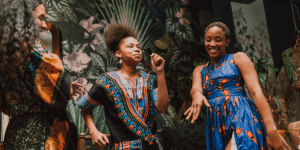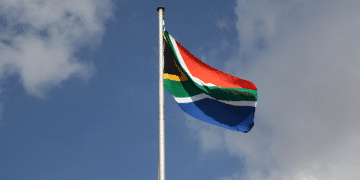Cross-Cultural Collaborations: Southern Africa’s Most Impactful Songs of 2024
The Rise of Southern African Music in 2024
The Southern African music scene is thriving in 2024, marked by a rich diversity of genres and the emergence of extraordinary talent.
This year has been pivotal for the region, with significant developments across hip-hop, electronic music, and jazz. Artists from South Africa, Lesotho, Zimbabwe, Botswana, and more are not only resonating with local audiences but also making a mark on the global music stage.
Major Musical Developments
Cross-Generational Hip-Hop Collaborations
2024 has seen a remarkable surge in collaborations between established and emerging hip-hop artists in Southern Africa.
Young talents like K. Keed and Usimamane have joined forces with seasoned artists, creating a vibrant cross-generational dialogue that has redefined the hip-hop landscape.
These collaborations are breaking down barriers and fostering a sense of unity within the industry, merging old-school authenticity with innovative new sounds.
Afro-Tech and Afro-House Growth
The electronic music scene, particularly Afro-tech and Afro-house, continues to expand at an impressive rate.
Leading artists such as Desiree, Kasango, and DJ Lag are at the forefront of this movement, bringing their unique sounds to international audiences.
These genres blend traditional African rhythms with modern electronic beats, creating infectious music that is garnering widespread acclaim.
Jazz Revival
South African jazz is experiencing a renaissance, highlighted by the revival of the prestigious Cape Town International Jazz Festival.
Artists like Linda Sikhakhane and Thandiswa Mazwai are breathing new life into the genre, blending classical jazz elements with contemporary influences.
This resurgence is not only preserving South Africa’s rich cultural heritage but also introducing jazz to new, younger audiences.
Increasing Global Influence
Southern African music is making significant inroads on the global stage.
Artists such as Tyla are leading this charge, adapting their local sounds for international appeal without compromising authenticity.
These musicians are increasingly featured in global playlists, collaborations, and major music festivals, underscoring the universal appeal of Southern African music.
Southern Africa’s musical journey in 2024 is a testament to the region’s creativity and resilience.
As artists continue to innovate and collaborate, their influence on the global music landscape is set to expand even further.
Looking forward, we will explore how these trends are fostering regional collaborations and strengthening Southern Africa’s musical identity.
| Category | Details |
|---|---|
| Artists | K. Keed: Gugulethu-born artist known for her style, collaborating with Nasty C. Usimamane: Durban emcee with collaborations with Mashbeatz, creating a versatile presence in the scene. |
| Impact of Collaborations | Shared Knowledge: Established artists offer guidance, while new talents bring fresh ideas. Cultural Exchange: Collaborations combine different styles and influences, creating unique sounds. Audience Expansion: These partnerships introduce artists to broader audiences, connecting generations. |
| Looking Ahead | Electronic music evolution: Afro-tech and Afro-house are becoming more internationally recognized, influencing the future of Southern African music. |
Electronic Music Evolution: Afro-Tech and House
Southern Africa’s electronic music scene is experiencing a thrilling transformation, with Afro-tech and Afro-house rising to international prominence.
These genres blend traditional African rhythms with modern electronic beats, creating a unique and captivating soundscape.
Ascendancy of Afro-Tech and Afro-House
Afro-tech, a sub-genre of house music, is defined by its deep, percussive grooves and hypnotic melodies.
The genre’s roots lie in traditional African rhythms, but it incorporates cutting-edge electronic production techniques.
Afro-house, on the other hand, retains more of the soulful, melodic elements of traditional house music while infusing it with African influences.
Influential Artists Leading the Charge
Several artists are at the forefront of this movement, infusing their unique styles and pushing the boundaries of Afro-tech and Afro-house.
- ✅Desiree: A dynamic DJ and producer, Desiree is known for her seamless blending of electronic beats with Afro-centric sounds. Her remix of Selaelo Selota’s “Thrrr… Phaaa!” is a testament to her innovative approach. By merging Afro-jazz with electronic grooves, she creates an intoxicating dance track that pays homage to her Sepedi heritage.
- ✅Kasango: Kasango has been captivating audiences with his deep house rhythms and melodic hooks. His ability to craft immersive soundscapes has made him a staple in the Afro-house scene, and his performances are a highlight at festivals worldwide.
- ✅DJ Lag: Often credited as one of the pioneers of Gqom, DJ Lag has broadened his horizons to include Afro-tech and Afro-house. His track “Oke Oke” features Spanish artist Jazz Alonso and is a perfect example of his genre-blending prowess. The song’s infectious beat and international flair have positioned DJ Lag as a global ambassador for South African electronic music.
Gaining International Recognition
The appeal of Afro-tech and Afro-house extends far beyond Southern Africa.
These genres have found enthusiastic audiences worldwide, from underground clubs in Berlin to major music festivals in Ibiza.
This international recognition is fueled by the genre’s universal energy and the authenticity of its cultural roots.
Artists like Desiree and DJ Lag are regularly booked for performances around the globe, helping to spread the sound of Afro-tech and Afro-house to new and diverse audiences.
Their music resonates not only for its infectious rhythms but also for the cultural narratives it weaves.
This growth in global recognition aligns with the broader narrative of Southern African music’s impact on the international stage.
As we continue to explore this vibrant region’s music scene, it becomes clear that the sounds emanating from Southern Africa are setting the pace for global music trends, influencing genres, and reshaping the musical landscape.
Jazz Renaissance and Cultural Heritage
Resurgence of South African Jazz
South African jazz is experiencing a significant resurgence in 2024, marking a profound period of cultural revival.
This year, the Cape Town International Jazz Festival made a triumphant return after a hiatus caused by the COVID-19 pandemic.
The festival, known for bringing together global jazz greats and local talent, drew large crowds and set the stage for South African jazz to shine once again.
Spotlight on Leading Jazz Artists

Linda Sikhakhane
Linda Sikhakhane stands out in this jazz renaissance.
His album “Iladi” has received critical acclaim and his signing to the legendary Blue Note record label marks a historic milestone, making him the third South
African artist to achieve this honor. Sikhakhane’s work blends traditional jazz with contemporary sounds, creating a fusion that is both innovative and deeply rooted in South African heritage.
Thandiswa Mazwai
Thandiswa Mazwai, another pivotal figure, continues to make waves with her powerful performances and musical ingenuity.
Her ability to merge jazz with indigenous South African music resonates with audiences, both locally and internationally.
Mazwai’s contribution to the genre not only preserves its rich history but also propels it into the future.
Innovation and Preservation
South African jazz artists today are not just preserving the genre’s cultural heritage; they are also innovating with fresh sounds and modern influences.
This dual approach ensures that jazz remains relevant and continues to evolve.
For instance, the influence of Afro-jazz leanings can be seen in modern tracks, such as the remix of Selaelo Selota’s classic by DJ Desiree, which adds a contemporary, upbeat flavor while maintaining its original essence.
Cultural Significance
Jazz has been instrumental in South Africa’s history, especially during the apartheid era when it served as a voice of resistance and cultural expression.
Today, it holds a symbolic place in celebrating the country’s heritage and its ongoing journey towards reconciliation and identity formation.
This year, celebrations like “Sikelela, Thirty Years On” underscore jazz’s enduring significance in South Africa’s cultural landscape.
Overall, the jazz revival in 2024 reflects a dynamic interplay of tradition and innovation, linking past struggles with present triumphs and future possibilities.
As Southern African music continues to grow in popularity worldwide, it shapes both the local cultural narrative and its global perception.
Next, we will examine how musical collaborations across Southern African borders are forging a united regional identity and contributing to the region’s rich musical tapestry.
Regional Diversity and Cross-Border Collaborations
One of the most exciting developments in Southern African music in 2024 is the blossoming of cross-border collaborations.
The region is rich in cultural diversity, and this is reflected in the breadth of musical exchange occurring between artists from different countries.
This trend enhances regional unity and enriches the Southern African musical tapestry.
Musical Exchanges Across Borders
Southern African countries, including Lesotho, Zimbabwe, Botswana, and South Africa, have seen an impressive surge in collaborative projects.
These projects often bridge traditional sounds and contemporary genres, creating unique blends that resonate with diverse audiences.
From Lesotho, Omali Themba’s “Mahlo A Batho” has captivated audiences with its heartfelt lyrics and boom-bap beats, showcasing the country’s hip-hop prowess.
Rising star Maleh, who has roots in both Lesotho and South Africa, continues to delight fans with her soul-stirring song “Mmoloki,” demonstrating the seamless blend of influences from both nations.
From Zimbabwe, Holy Ten shines with “Very Tight,” representing the new wave of Zimbabwean emcees who balance traditional rap elements with modern spins.
Tamy Moyo’s collaboration with Master H. on “Kelly Kelvhedhura” has also struck a chord, combining Zim dancehall vibes with mainstream appeal.
Botswana contributes with artists like William Last KRM, whose track “Today” provides a fresh take on popular sounds from the ’90s.
His comedic flair adds a unique layer, making his music both entertaining and innovative. Mpho Sebina’s “Tshepo” has also made waves, with its message of self-love resonating with listeners across the region.
Strengthening Regional Identity
These collaborations are more than just musical endeavors; they represent the deepening connections between the people of Southern Africa.
By working together, artists create a shared cultural identity that transcends national borders. This unity is crucial in a global music industry that often prioritizes diversity and distinctiveness.
Indeed, the cross-border musical exchanges have led to a stronger regional identity that’s not only appreciated locally but also gaining recognition internationally.
For example, Denimwoods’ collaboration with Takura on “DAISO” (Zimbabwe/DRC) brings together the best of both regions’ musical talents, making it a hit across national lines.
Impact on Regional Music Scene
The growing number of cross-border collaborations is undoubtedly strengthening the Southern African music scene.
Artists are learning from each other, exchanging ideas, and pushing creative boundaries. This not only enhances the quality of the music produced but also ensures a dynamic and evolving musical landscape.
As Southern African music continues to thrive, it is clear that these collaborations will play a vital role in shaping its future.
By fostering a spirit of unity and creativity, artists from different countries are ensuring that Southern Africa remains a vibrant and influential region in the global music industry.
Moving forward, it will be interesting to see how these cross-border relationships evolve and what new musical fusions will emerge.
Global Impact and Future Prospects
Southern Africa’s Soaring Global Presence
In 2024, Southern African music is making waves internationally, with its unique sound captivating audiences worldwide.
One of the key figures in this rise is Tyla, whose involvement in high-profile collaborations with international artists like Skillibeng and Gunna has showcased the region’s vibrant talent on a global stage.
Tyla’s track “Jump” epitomizes the energetic and innovative spirit of Southern African artists as they blend genres seamlessly, redefining musical boundaries.
Adapting Local Sounds for Global Audiences
Artists from Southern Africa are skillfully adapting their rich musical traditions to fit the tastes of international audiences while preserving their authenticity.
Afro-tech and Afro-house continue to enchant global listeners, with pioneers like Desiree and DJ Lag introducing beats that resonate with diverse cultural palettes.
By infusing traditional rhythms with contemporary electronic soundscapes, these artists create a captivating fusion that remains true to their roots while appealing to global sensibilities.
Envisioning the Future of Southern African Music
Looking ahead, Southern African music is poised to further solidify its place in the global music market.
The continued success of boundary-pushing artists like Tyla indicates a promising trajectory for the region’s music industry.
By embracing both traditional elements and modern innovation, Southern African musicians are not just keeping their cultural heritage alive but are also enhancing it with a fresh, global resonance.
As regional musical diversity and cross-border collaborations continue to enrich the Southern African music scene, their influence is bound to grow, inviting new fans from around the world to explore and celebrate this dynamic soundscape.





